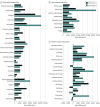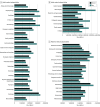Addressing Gender-Based Disparities in Earning Potential in Academic Medicine
- PMID: 35179582
- PMCID: PMC8857688
- DOI: 10.1001/jamanetworkopen.2022.0067
Addressing Gender-Based Disparities in Earning Potential in Academic Medicine
Abstract
Importance: Gender-based disparities in compensation in academic medicine are recognized, but their estimated impacts on early career earning potential and strategies to mitigate them have not been well studied.
Objectives: To compare earning potential between female and male academic physicians in the first 10 years of posttraining employment and to evaluate the estimated impact of promotion timing, starting salary, and salary growth rate on earning potential.
Design, setting, and participants: Using publicly available mean debt and compensation data for full-time employed academic physicians in the US from 2019 to 2020, starting salary, salary in year 10 of employment, annual salary growth rate, and overall earning potential in the first 10 years of employment were estimated for each gender by subspecialty. The estimated impacts of promotion timing and potential interventions, including equalizing starting salaries and annual salary growth rates, were modeled. Data analysis was performed from March to May 2021.
Exposures: Gender and subspecialty.
Main outcomes and measures: Starting salary, annual salary growth rate, year-10 salary, and earning potential in first 10 years of employment.
Results: This cross-sectional study included compensation data from 24 593 female and 29 886 male academic physicians across 45 subspecialties. Women had lower starting salaries in 42 of 45 subspecialties (93%), year-10 salaries in 43 of 45 subspecialties (96%), mean annual salary growth rates in 22 of 45 subspecialties (49%), and earning potential in 43 of 45 subspecialties (96%) (median [IQR], $214 440 [$130 423-$384 954], or 10%, less). A 1-year delay in promotion from assistant to associate professor reduced women's earning potential by a median (IQR) of $26 042 ($19 672-$35 671), but failure to be promoted at all reduced it by a median (IQR) of $218 724 ($176 317-$284 466). Equalizing starting salaries could increase women's earning potential by a median (IQR) of $250 075 ($161 299-$381 799) in the subspecialties for which starting salaries for women were lower than those for men. Equalizing annual salary growth rates could increase women's earning potential by a median (IQR) of $53 661 ($24 258-$102 892) in the subspecialties for which mean annual salary growth rates were lower for women than for men.
Conclusions and relevance: The findings of this study suggest that gender-based disparities in starting salary and early career earning potential are pervasive in academic medicine in the US. Equalizing starting salaries would address the majority of the differences in earning potential.
Conflict of interest statement
Figures


Comment in
-
Measuring and Mitigating Gender-Based Disparities in Earning Potential in Academic Medicine.JAMA Netw Open. 2022 Feb 1;5(2):e220074. doi: 10.1001/jamanetworkopen.2022.0074. JAMA Netw Open. 2022. PMID: 35179591 No abstract available.

